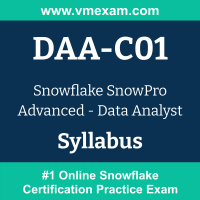 The Snowflake DAA-C01 exam preparation guide is designed to provide candidates with necessary information about the SnowPro Advanced - Data Analyst exam. It includes exam summary, sample questions, practice test, objectives and ways to interpret the exam objectives to enable candidates to assess the types of questions-answers that may be asked during the Snowflake Certified SnowPro Advanced - Data Analyst exam.
The Snowflake DAA-C01 exam preparation guide is designed to provide candidates with necessary information about the SnowPro Advanced - Data Analyst exam. It includes exam summary, sample questions, practice test, objectives and ways to interpret the exam objectives to enable candidates to assess the types of questions-answers that may be asked during the Snowflake Certified SnowPro Advanced - Data Analyst exam.
It is recommended for all the candidates to refer the DAA-C01 objectives and sample questions provided in this preparation guide. The Snowflake SnowPro Advanced - Data Analyst certification is mainly targeted to the candidates who want to build their career in Advance domain and demonstrate their expertise. We suggest you to use practice exam listed in this cert guide to get used to with exam environment and identify the knowledge areas where you need more work prior to taking the actual Snowflake SnowPro Advanced - Data Analyst exam.
Snowflake DAA-C01 Exam Summary:
| Exam Name | Snowflake SnowPro Advanced - Data Analyst |
| Exam Code | DAA-C01 |
| Exam Price | $375 USD |
| Duration | 115 minutes |
| Number of Questions | 65 |
| Passing Score | 750 + Scaled Scoring from 0 - 1000 |
| Recommended Training / Books |
Snowflake Data Analyst Training SnowPro Advanced: Data Analyst Exam Study Guide |
| Schedule Exam | PEARSON VUE |
| Sample Questions | Snowflake DAA-C01 Sample Questions |
| Recommended Practice | Snowflake Certified SnowPro Advanced - Data Analyst Practice Test |
Snowflake SnowPro Advanced - Data Analyst Syllabus:
| Section | Objectives | Weight |
|---|---|---|
| Data Ingestion and Data Preparation |
- Use a collection system to retrieve data.
- Perform data discovery to identify what is needed from the available datasets.
- Enrich data by identifying and accessing relevant data from the Snowflake Marketplace.
- Outline and use best practice considerations relating to data integrity structures.
- Implement data processing solutions.
- Given a scenario, prepare data and load into Snowflake.
- Given a scenario, use Snowflake functions.
|
17% |
| Data Transformation and Data Modeling |
- Prepare different data types into a consumable format.
- Given a dataset, clean the data.
- Given a dataset or scenario, work with and query the data.
- Use data modeling to manipulate the data to meet BI requirements.
- Optimize query performance.
|
23% |
| Data Analysis |
- Use SQL extensibility features.
- Perform a descriptive analysis.
- Perform a diagnostic analysis.
- Perform forecasting.
|
32% |
| Data Presentation and Data Visualization |
- Given a use case, create reports and dashboards to meet business requirements.
- Given a use case, maintain reports and dashboards to meet business requirements.
- Given a use case, incorporate visualizations for dashboards and reports.
|
28% |
